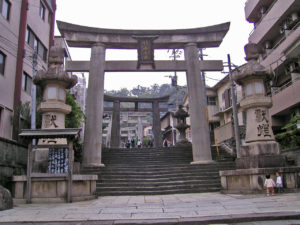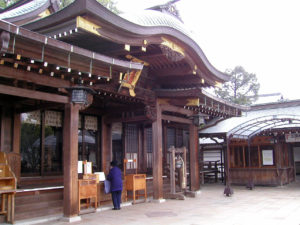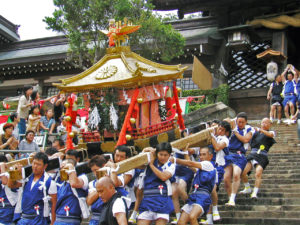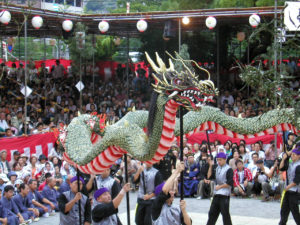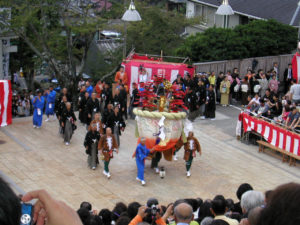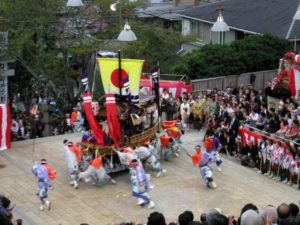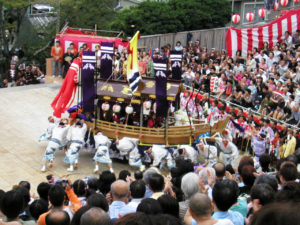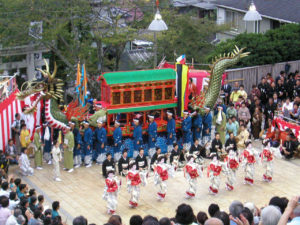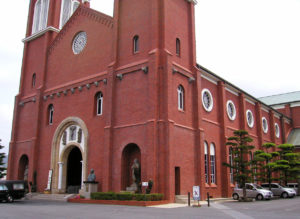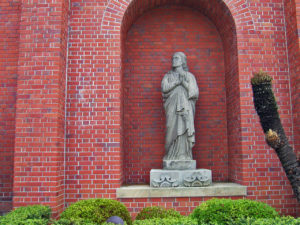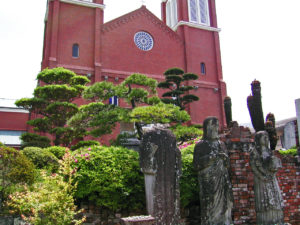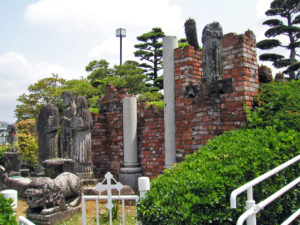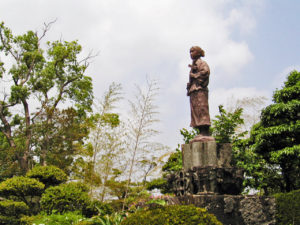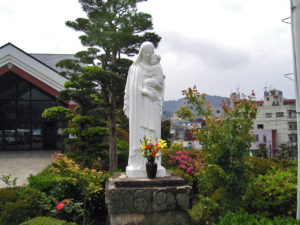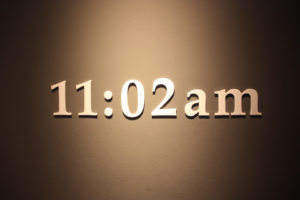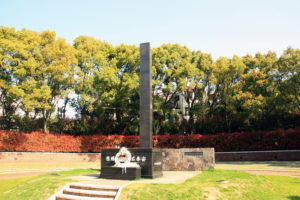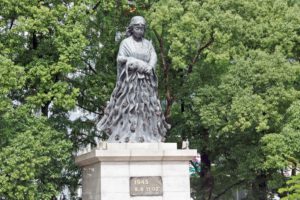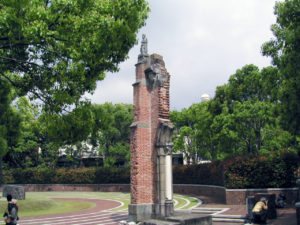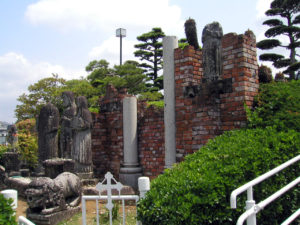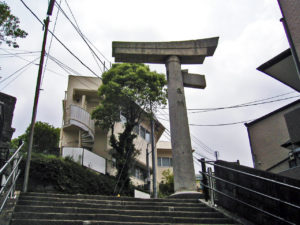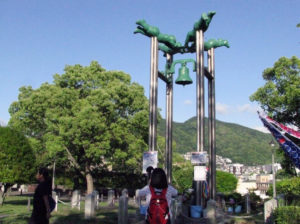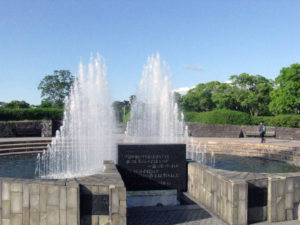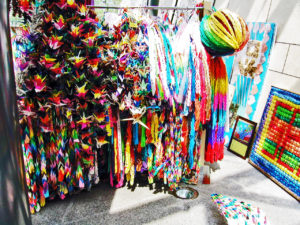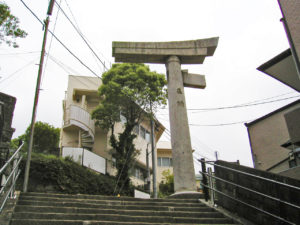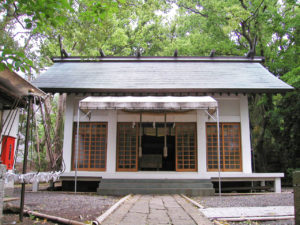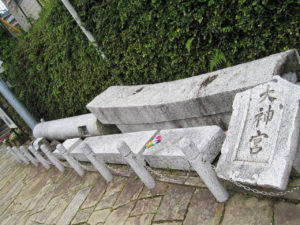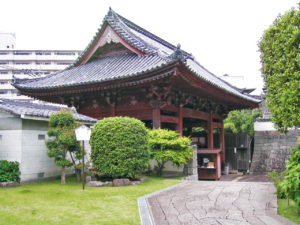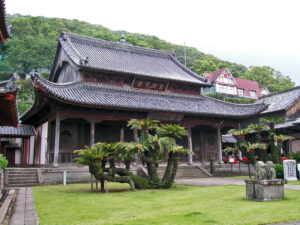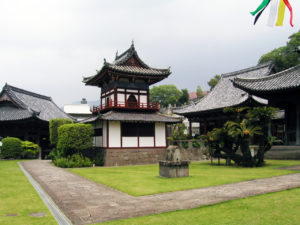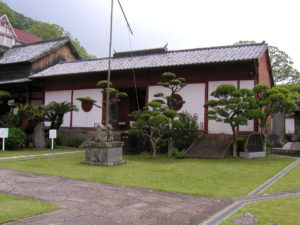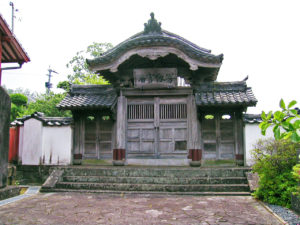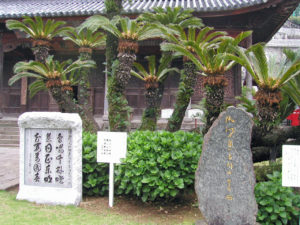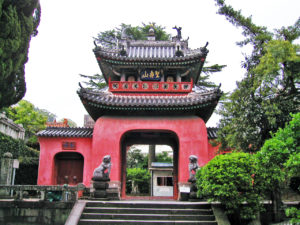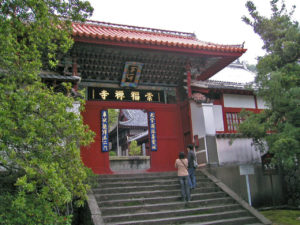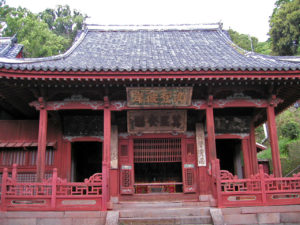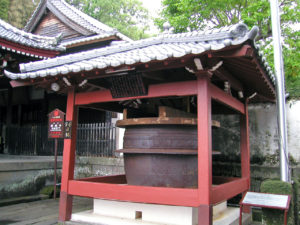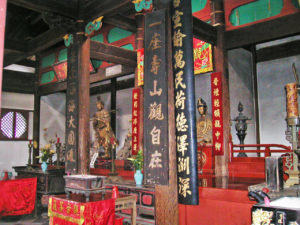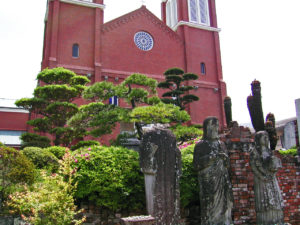Suwa Shrine
The complex of building and gardens comprising Suwa Shrine nestles on a shaded stretch of
hillside overlooking the heart of Nagasaki-city. The shrine was founded in the wake of ban
of Christianity in the early 17th century, and during the Edo Period it soon grew into a spiritual
and cultural hub for the citizens of Nagasaki. During Meiji and Taisho Periods, it was not only
Nagasaki’s foremost Shinto shrine but also this city’s most popular destination for foreign tourist
who came seeking a glimpse into heart of Japan.
|
|
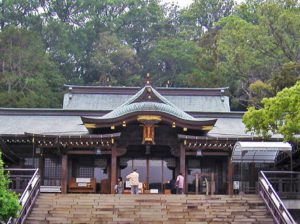 |
|
Held from October 7 to 9 every year and is considered one of the three major festivals of
Japan, being designated as an Important Intangible Cultural Asset.
General information
| Address | 18-15 Nishiyama-cho, Nagasaki-city |
| Access |
A short walk from Suwa-jinjya Tram station |
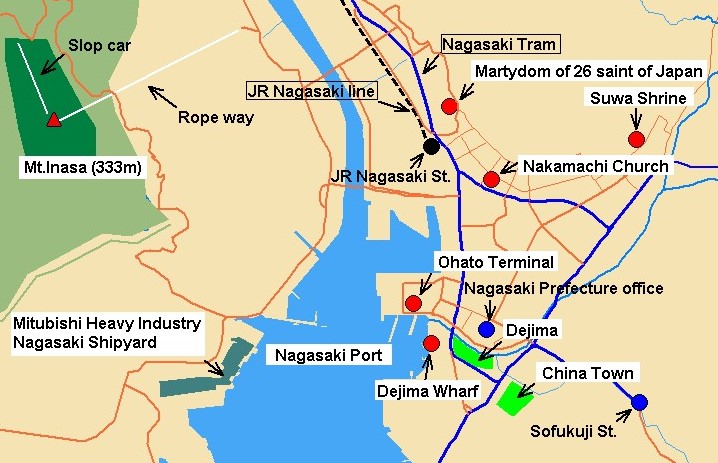
Urakami Cathedral
Construction of the original Urakami Cathedral, a brick Romanesque building, began in 1895,
after a long-standing ban on Christianity was lifted.
When completed in 1914, it was the largest Catholic church in East Asia.
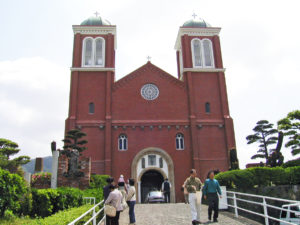 |
|
|
The Atomic bomb dropped on August 9, 1945 explored in Urakami, only 500m from the cathedral,
which was completely destroyed.
What remained of the cathedral is now on display in the Atomic Bomb Museum.
A replacement was built in 1959, and remodeled to more closely resemble the original in 1980.
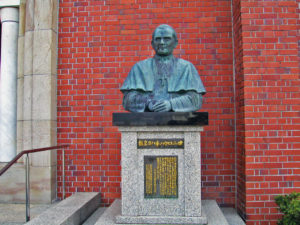 |
|
|
The nearby the Ground Zero in Peace Park contains remnants of the Ruins of Urakami Cathedral
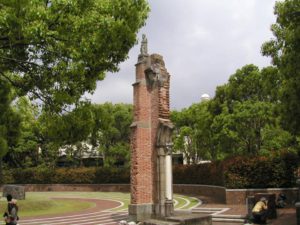 |
|
|
General information
| Address | 1-79 Moto-machi, Nagasaki-city |
| Access |
8 minutes walk from Heiwa koen Tram Station |
| Open hours |
9:00 to 17:00 |
| Admission fee | No fee is required, please donate to the donation box |
| Days closed | No closing days |
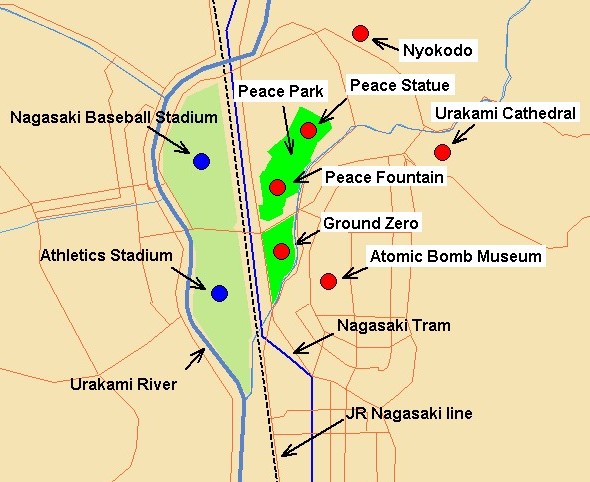
Home Tailor-made tours Study tours Christian Pilgrimage tours Golf tour Kyushu tour packages
Gunkan-jima island cruise
The cruise ship take you exploring Tachibana bay from Nagasaki port and landing on Hashima
island. The site has been registered on UNESCO World Heritages as Sites of Japan’s Meiji
Now Hashima is a ruins called “Gunkanjima”, so called after its resemblance to the
silhouette. Hashima Island is located 3 km southwest of Takashima, and it was the success of
Takashima that led Mitsubishi to purchase this island, both islands giving access to the same
undersea coal deposit.
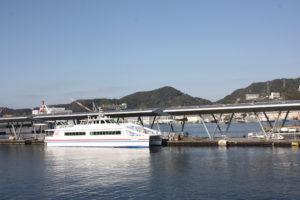 |
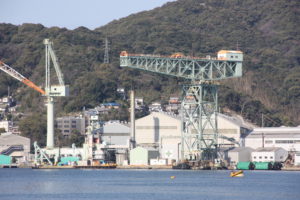 |
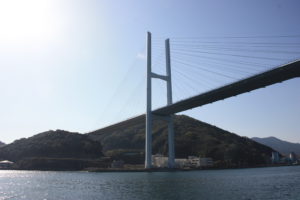 |
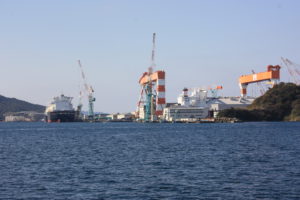 |
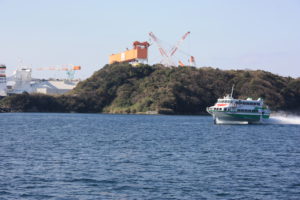 |
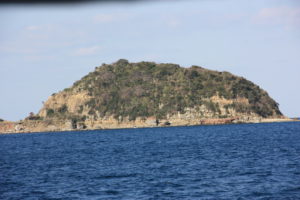 |
Hashima coal mining island is an artificial reclaimed island and the site of Japan’s first major
undersea coal exploitation pioneered by Mitsubishi – and host to one of the world’s most
extraordinary former mining communities
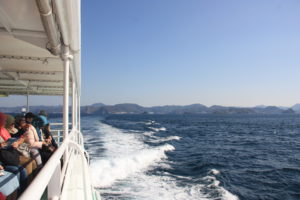 |
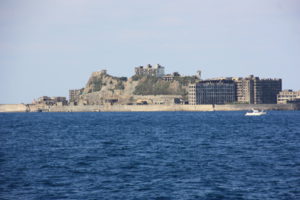 |
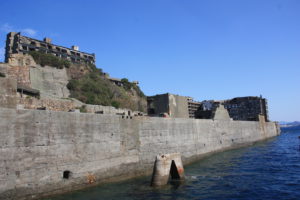 |
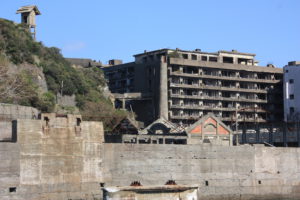 |
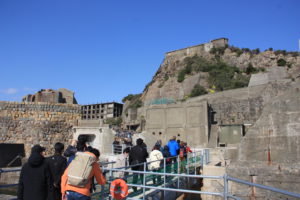 |
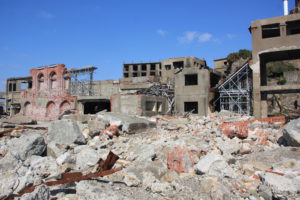 |
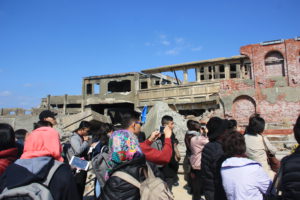 |
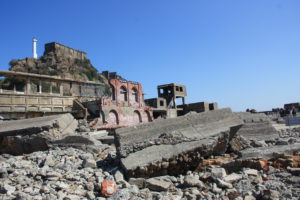 |
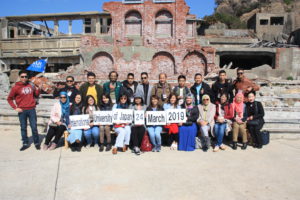 |
General information
| Address | Hashima Takashima, Nagasaki-city |
| Access |
about 40 by a ferry from Nagasaki port |
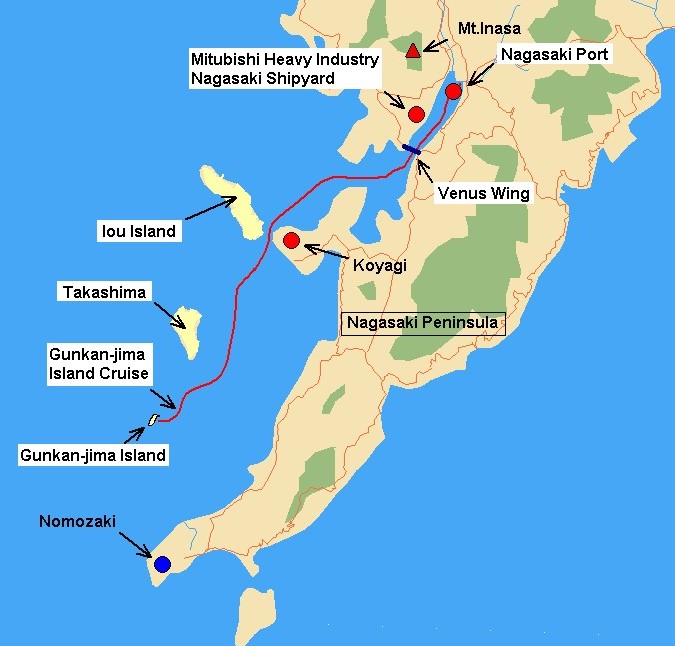
Atomic Bomb Museum
Atomic Bomb Museum opened in Nagasaki Peace Park in 1996 as part of the 50th anniversary
project for the Nagasaki atomic bombing.
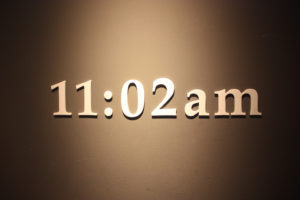 |
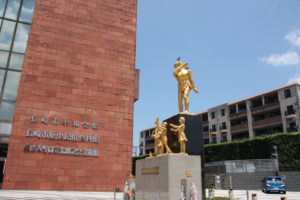 |
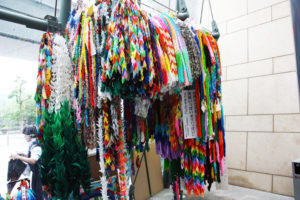 |
The museum replaced Nagasaki International Cultural Hall, where a number of artifacts related to
the atomic bombing were exhibited.
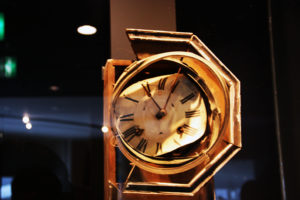 |
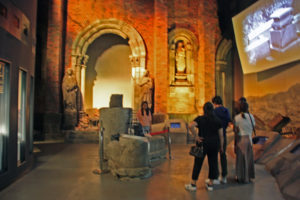 |
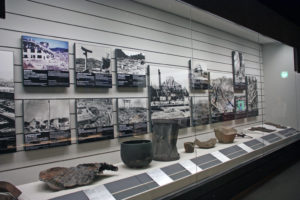 |
In addition to these artifacts, the museum exhibits a number of photograph that depict the devastation
caused by atomic bomb showing the lead-up to this tragic day, the history of the development of
nuclear arms and our desire for peace.
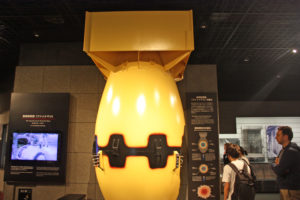 |
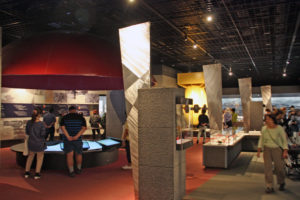 |
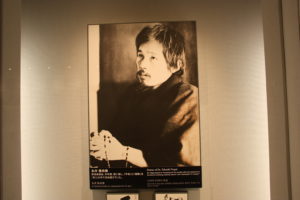 |
Pope Francis visited Nagasaki on November 24, 2019.
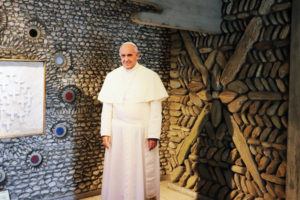 |
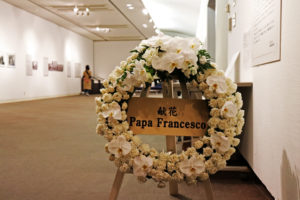 |
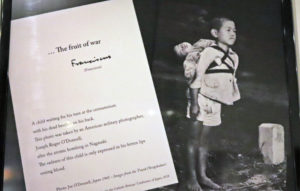 |
General information
| Address | 7-8 Hirano-machi, Nagasaki-city |
| Access |
5 minutes walk from Genbaku-shiryokan Tram Station |
| Open hours |
8:30 to 17:30 September to December 8:30 to 18:30 May to August 8:30 to 20:00 August 7 to 9 |
| Admission fee | JPY 200 |
| Days closed | December 29 to 31 |

Home Tailor-made tours Study tours Christian Pilgrimage tours Golf tour Kyushu tour packages
Peace Fountain at Peace Park
Peace Fountain reminds us of the tragic scene unfolded shortly after America dropped
the Atomic Bomb on Nagasaki at 11:02 am on Aug. 09, 1945. With the completion of the
Peace Fountain on Aug. 3, 1969, a monument inscribed with an epitaph was constructed.
Many people were burned deeply and died, crying and groaning for water. When people
recovered their peaceful life in 1965, a campaign for a Peace Fountain was launched.
Recorded on the monument are the name of the founder including the People’s Congress
for Prohibition of Nuclear Weapons and Promotion of Peace and the Committee for the
Construction of the Peace Fountain.
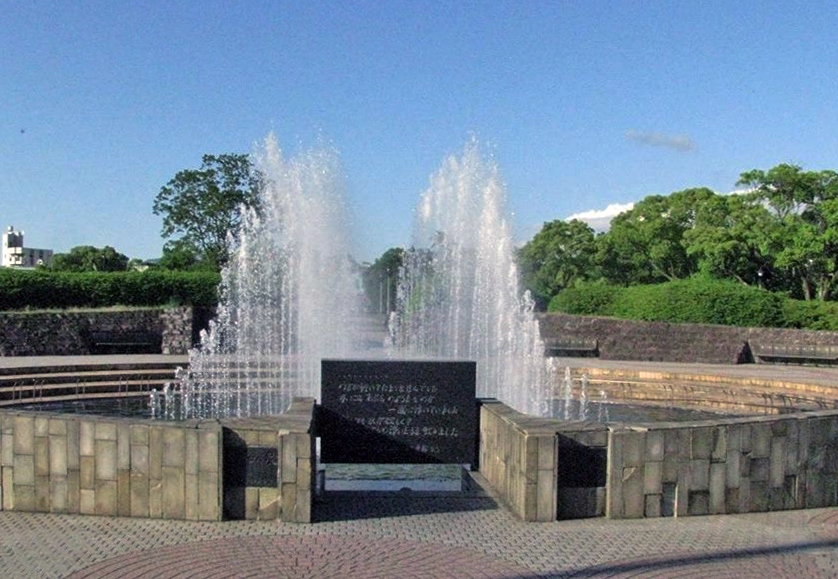 |
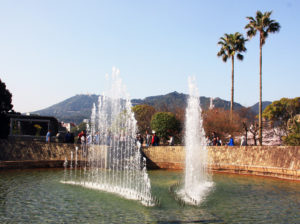 |
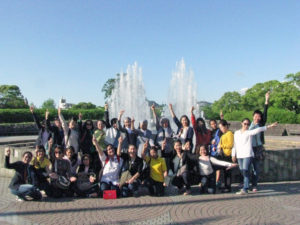 |
Part of the epitaph reads as follows: To those who visit this place today. May you offer prayers
to console the souls of those killed and promote peace.
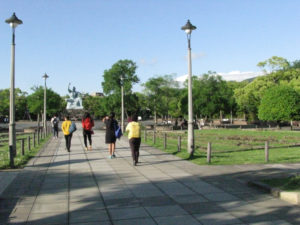 |
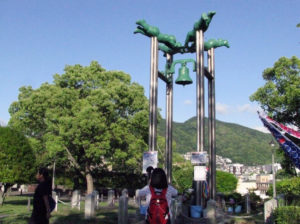 |
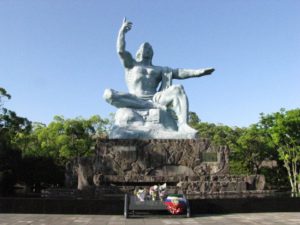 |
General information
| Address | Heiwakoen, Matsuyama-machi, Nagasaki-city |
| Access | 3 minutes walk from Heiwa-koen-shita Tram Station |

Atomic bomb in Nagasaki
Disastrous War must not be repeated.
The plutonium atomic bomb exploded about 500m over the central monument
at 11:02 a.m. on August 9, 1945.
The most part of Nagasaki was destroyed, and a tremendous number of lives were lost.
And about 70,000 of Nagasaki’s 240,000 residents died instantly, and up to 60,000 were injured.
|
The time, Atomic bomb was exploded |
Atomic bomb exploded over the central monument |
Nuked 50th Anniversary Monument |
The radius of total destruction was about 1.6km, followed by fires across the northern portion of the
city to 3.2km south of the bomb.
|
Ruin of destroyed Urakami Cathedral |
Ruin of destroyed Urakami Cathedral |
The one leg Torii gate at Sanno Shrine |
The total number of residents died may have been as many as 80,000, including those who died
from radiation poisoning in the following months. Even now, many atomic bomb survivors are
suffering. The list of names of the atomic bomb victim who died up to now is stored in the monument.
|
The Bell of Nagasaki |
Peace Fountain |
Folding paper cranes pray for peace |
Home Tailor-made tours Study tours Christian Pilgrimage tours Golf tour Kyushu tour packages
Damaged Torii at Sanno Shrine
The damaged Torii ( stone archway on the path to a shrine ) by the atomic bombing
is located about 800 m southeast of Ground Zero located in the present Nagasaki
|
|
|
|
The pillar and beams on the side near Ground Zero were slapped down by the blast,
leaving only half of the structure standing.
This strange damage was caused by exposure to a brief but tremendous blast stone.
The blast wind shifted the beam at the top of Torii, grazed the surface of pillar facing
Ground Zero and erased the names of donators that had been engraved there.
One of the few relics of the atomic wasteland still standing on its original site, this
Torii speaks silently of the awesome power generated by the atomic bomb explosion.
Home Tailor-made tours Study tours Christian Pilgrimage tours Golf tour Kyushu tour packages
Kofukuji Temple
After the Tokugawa Shogunate banned Christianity, non-Christian Chinese merchants
began making port at Nagasaki around 1600. Chinese people soon started living in Nagasaki
and etitioned the Nagasaki government to let them built a Chinese temple to pray for safe
navigation and console of the deceased. Permission was granted for the construction of
first Chinese temple.
|
|
|
|
Kofukuji Temple was completed in 1620, and Chinese traders then planned to invite a high-ranking
priest from China as the temple’s chief abbot. The Kofukuji Temple’s present main hall was built in
1883 by Chinese experts who were invited to Japan mainly by residents in Nagasaki hailing from
Nanjin. It was designated as an Important Cultural Asset.
|
|
|
|
Location of Nagasaki-city
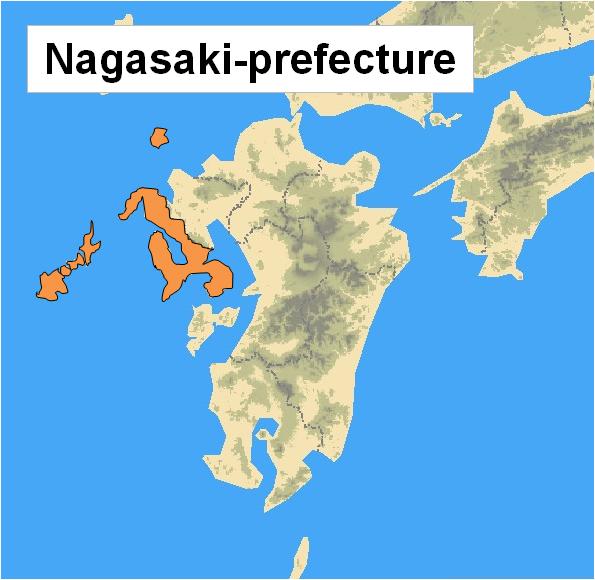
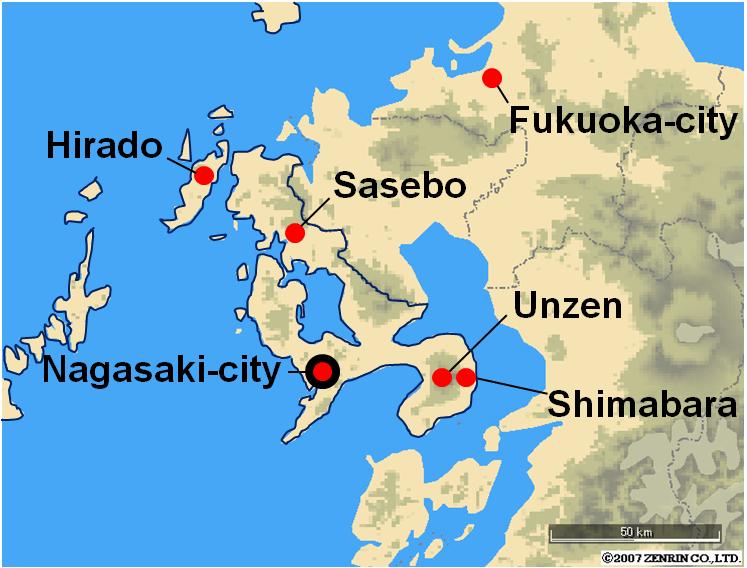
General information
| Address | 4-32 Teramachi, Nagasaki-city |
| Access |
A short walk from Shiminkaikan Tram station |
Sofukuji Temple
The first Chinese style temple in Nagasaki. Shortly after the construction of Kofukuji Temple,
Chinese traders asked the Nagasaki governor for permission to built Chinese temples
according to their home provinces. It is recorded that this temple was built in 1629 by people
who came from Fuzhou in Fujian Province. It is designated as a National Treasure.
|
|
|
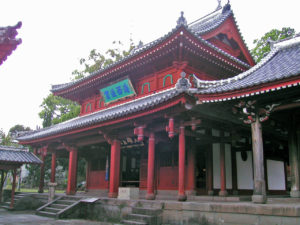 |
The existing main hall ( called Daiyuhoden ) was first prefabricated in China, then transported by
Chinese ship and constructed in 1646. As the oldest existing structure to retain the Obaku style
of the end of the Ming Dynasty, the temple’s hall is highly evaluated.
|
|
|
|
Location of Nagasaki-city


General information
| Address | 7-5 Kajiya-machi, Nagasaki-city |
| Access |
A short walk from Sofukuji Tram station |
Ruins of Urakami Cathedral
When you look to the right facing the Ground zero Monument see a sectionof damaged brick
wall from the former Urakami Cathedral. The church was located about 500 m northeast of
theGround zero, on the same site as the modern refurbished Urakami Cathedral. The construction
of former building began in 1895 and continued until 1925, when the twin steeples reached
completion.
|
Ruin of destroyed Urakami Cathedral |
Ruin of destroyed Urakami Cathedral |
Present Urakami Cathedral |
Known at that time as the largest church in Orient, the imposing red-brick structure was devastated
by the atomic bomb explosion, and a large number of parishioners were killed. In 1958, part of the
damaged eleven-meter-tall southern wall was moved to Nagasaki Peace Park. The new cathedral
was rebuilt in hornor of those lost. It was reconstructed to its present shape in 1959 and the brick
construction was renovated in 1980, a year before the Pope’s visit.
Location of Nagasaki-city



